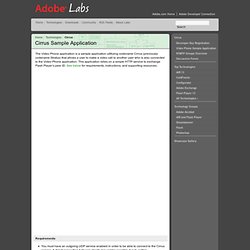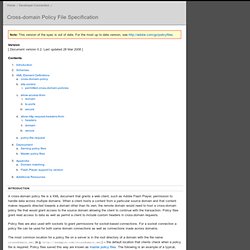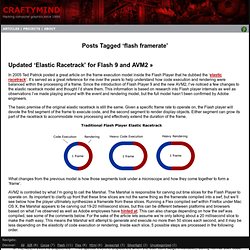

Actionscript. Header. Animation. Labs - Stratus Sample Application. The Video Phone application is a sample application utitlizing codename Cirrus (previously codename Stratus) that allows a user to make a video call to another user who is also connected to the Video Phone application.

This application relies on a simple HTTP service to exchange Flash Player’s peer ID. See below for requirements, instructions, and supporting resources. Requirements You must have an outgoing UDP service enabled in order to be able to connect to the Cirrus service. A direct connection between clients may not be possible due to certain combinations of firewalls. Instructions Type a user name in the text box and click connect; use a unique string, such as your e-mail address as your user name Once connected to Cirrus, enter the user name of someone whom you would like to call, and click CALL You will be prompted to share your microphone and/or camera by the Flash Player If you are the recipient of the call, you will be prompted to accept or reject the incoming call.
Updated ‘Elastic Racetrack’ for Flash 9 and AVM2 « Craftymind. In 2005 Ted Patrick posted a great article on the frame execution model inside the Flash Player that he dubbed the ‘elastic racetrack‘. It’s served as a great reference for me over the years to help understand how code execution and rendering were balanced within the processing of a frame. Since the introduction of Flash Player 9 and the new AVM2, I’ve noticed a few changes to the elastic racetrack model and thought I’d share them.
This information is based on research into Flash player internals as well as observations I’ve made playing around with the event and rendering model, but the full model hasn’t been confirmed by Adobe engineers. The basic premise of the original elastic racetrack is still the same. Given a specific frame rate to operate on, the Flash player will devote the first segment of the frame to execute code, and the second segment to render display objects. AVM2 is controlled by what I’m going to call the Marshal.
So what does this all mean? Cross-domain Policy File Specification. Note: This version of the spec is out of date.

For the most up to date version, see Updates: March 22, 2008 Added Sockets flowchart March 24, 2008 Removed www from master policy file URL examples Small spelling/plural/etc. edits March 28, 2008 Added #IMPLIED to to-ports in inline DTD Included question TODO on last domain matching example Version [ Document version 0.2. Contents Introduction A cross-domain policy file is a XML document that grants a web client, such as Adobe Flash Player, permission to handle data across multiple domains. Policy files are also used with sockets to grant permissions for socket-based connections. The most common location for a policy file on a server is in the root directory of a domain with the file name crossdomain.xml (e.g. -- the default location that clients check when a policy file is required. The site-control element here specifies that only this master policy file should be considered valid on this domain. Schemas Table 2.1: Schema links cross-domain-policy. Flash framerate « Craftymind.
In 2005 Ted Patrick posted a great article on the frame execution model inside the Flash Player that he dubbed the ‘elastic racetrack‘.

It’s served as a great reference for me over the years to help understand how code execution and rendering were balanced within the processing of a frame. Since the introduction of Flash Player 9 and the new AVM2, I’ve noticed a few changes to the elastic racetrack model and thought I’d share them. This information is based on research into Flash player internals as well as observations I’ve made playing around with the event and rendering model, but the full model hasn’t been confirmed by Adobe engineers. The basic premise of the original elastic racetrack is still the same. Given a specific frame rate to operate on, the Flash player will devote the first segment of the frame to execute code, and the second segment to render display objects. AVM2 is controlled by what I’m going to call the Marshal.
So what does this all mean?